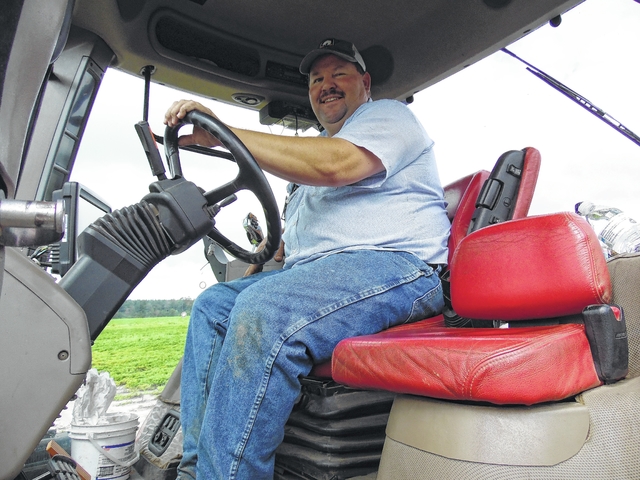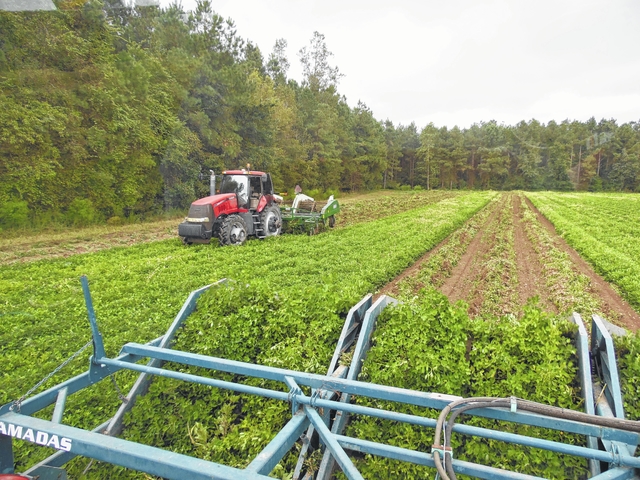LUMBERTON — A balance of sufficient rain and sunshine this summer have created conditions for what could be a bumper corn crop as well as good yields for peanuts and soybeans.
Jimmy Pate, a Robeson County farmer who grows corn, soybeans and tobacco, said he and other farmers have seen an above average yield in corn this year and most of the corn throughout the county has been harvested. Pate grew 880 acres of corn this year.
“Of course Robeson County is a big county. There are always pockets that are a little dry or a little wet,” Pate said, “but as a whole, I think it’s probably the best corn crop this county’s ever had — yield wise.”
That doesn’t guarantee a big profit.
“Corn prices are cheap.” Pate said.
Kevin Roberts said Roberts Farms had approximately 2,000 acres of corn and most of that has been harvested. His yields have also been above average for corn, although some fields had too much rain.
Mac Malloy, agriculture extension agent for field crops in Robeson County said growers planted between 65,000 and 70,000 acres of corn in Robeson County this year and most have also reported good yields.
“I think that corn, for the most part in the county as a whole, it’s been above average,” Malloy said.
Pate also grew tobacco, which had good yields and he raised soybeans, which are not yet ready for harvest. He said the tobacco crop was hit by the heat but overall it did well, yielding about 2,600 pounds per acre.
Adrian Locklear planted 1,600 acres of corn, 1,100 acres of soybeans and said his corn yields are also above average. An acre typically brings about 100 bushels per acre but this year his corn harvest brought about 125 bushels per acre.
“Soybeans have yet to be determined but it looks like they are going to be average or above average — I’ll say 35 bushels to the acre,” Locklear said.
He said soybeans average 30 bushels per acre.
Typically farmers plant between 80,000 acres and 85,000 acres of soybeans in Robeson County, Malloy said. “The numbers vary depending on factors such as the price soybeans will bring.
Malloy said soybeans have a longer time span to mature than some crops because they are planted based on the maturity group in which they fit. As seed supply was somewhat limited in the spring, that forced some growers to plant some earlier maturing varieties of soybean seeds, Malloy said.
Some soybeans will be ready for harvest around the first of October, he said, while others will be ready toward the end of October.
Farmers planted approximately 3,000 acres of peanuts this year in Robeson County, and harvest got under way last week. Peanut growers first have to turn the plants over to expose the roots so the peanuts can finish maturing. About a week later, depending upon the weather, farmers go back into the field with a peanut combine to actually harvest the peanuts.
Rainfall in the early part of the spring was sufficient, then it became dry for a while which led to a problem with spider mites which are more likely to attack peanut plants that are dry and stressed, Malloy said. However, rains later came in time to benefit the crop.
“It looks we have a good compact peanut crop,” Malloy said. “In other words there’s not a very wide spread in maturity. They should be good for harvest this year.”
With the corn harvested, 600 acres of peanuts are next, then Roberts and his brother Gary will harvest 1,400 acres of soybeans by late October, Roberts said. They began harvesting on Thursday and are optimistic about the yields but not the price.
“The market is flooded with peanuts right now – that’s why the price is down,” Roberts said. “There’s so many peanuts in storage.”
In the meantime, they will soon begin the process of defoliating their 300 acre cotton crop so its leaves fall off and the cotton bolls open.
“We cut back on cotton this year – we’re tired of working for nothing,” Roberts said.
He said cotton prices are “bouncing around” and getting closer to 70 cents per pound.
“Corn is the driver now and with corn (prices) being down, it sort of brings everything else down along with it,” Roberts said. “Everybody else with other crops looks at it and say, ‘Well, if you’re still willing to plant corn at that price, you’re willing to plant our crops at this price.”
Prices are definitely affected by overseas markets, he said.
“China holds 60 percent of the world’s cotton in storage so they can hold the price where they want it,” Robert said.
Pate described farming as a risky business with high input costs and the cost of machinery, but at the same time, he wouldn’t want to do anything else.
“It’s a good way of life,” Pate said.



